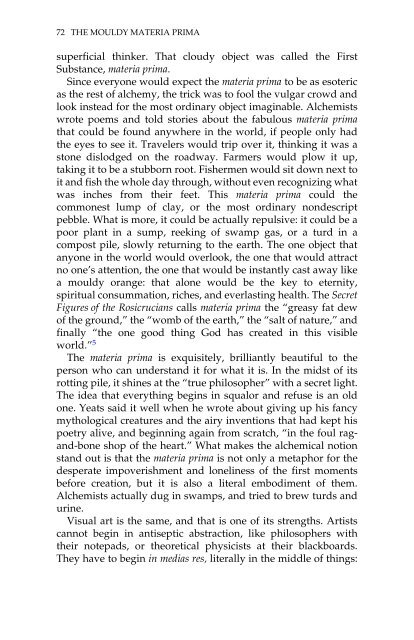What Painting Is: How to Think about Oil Painting ... - Victoria Vesna
What Painting Is: How to Think about Oil Painting ... - Victoria Vesna
What Painting Is: How to Think about Oil Painting ... - Victoria Vesna
You also want an ePaper? Increase the reach of your titles
YUMPU automatically turns print PDFs into web optimized ePapers that Google loves.
72 THE MOULDY MATERIA PRIMA<br />
superficial thinker. That cloudy object was called the First<br />
Substance, materia prima.<br />
Since everyone would expect the materia prima <strong>to</strong> be as esoteric<br />
as the rest of alchemy, the trick was <strong>to</strong> fool the vulgar crowd and<br />
look instead for the most ordinary object imaginable. Alchemists<br />
wrote poems and <strong>to</strong>ld s<strong>to</strong>ries <strong>about</strong> the fabulous materia prima<br />
that could be found anywhere in the world, if people only had<br />
the eyes <strong>to</strong> see it. Travelers would trip over it, thinking it was a<br />
s<strong>to</strong>ne dislodged on the roadway. Farmers would plow it up,<br />
taking it <strong>to</strong> be a stubborn root. Fishermen would sit down next <strong>to</strong><br />
it and fish the whole day through, without even recognizing what<br />
was inches from their feet. This materia prima could the<br />
commonest lump of clay, or the most ordinary nondescript<br />
pebble. <strong>What</strong> is more, it could be actually repulsive: it could be a<br />
poor plant in a sump, reeking of swamp gas, or a turd in a<br />
compost pile, slowly returning <strong>to</strong> the earth. The one object that<br />
anyone in the world would overlook, the one that would attract<br />
no one’s attention, the one that would be instantly cast away like<br />
a mouldy orange: that alone would be the key <strong>to</strong> eternity,<br />
spiritual consummation, riches, and everlasting health. The Secret<br />
Figures of the Rosicrucians calls materia prima the “greasy fat dew<br />
of the ground,” the “womb of the earth,” the “salt of nature,” and<br />
finally “the one good thing God has created in this visible<br />
world.” 5<br />
The materia prima is exquisitely, brilliantly beautiful <strong>to</strong> the<br />
person who can understand it for what it is. In the midst of its<br />
rotting pile, it shines at the “true philosopher” with a secret light.<br />
The idea that everything begins in squalor and refuse is an old<br />
one. Yeats said it well when he wrote <strong>about</strong> giving up his fancy<br />
mythological creatures and the airy inventions that had kept his<br />
poetry alive, and beginning again from scratch, “in the foul ragand-bone<br />
shop of the heart.” <strong>What</strong> makes the alchemical notion<br />
stand out is that the materia prima is not only a metaphor for the<br />
desperate impoverishment and loneliness of the first moments<br />
before creation, but it is also a literal embodiment of them.<br />
Alchemists actually dug in swamps, and tried <strong>to</strong> brew turds and<br />
urine.<br />
Visual art is the same, and that is one of its strengths. Artists<br />
cannot begin in antiseptic abstraction, like philosophers with<br />
their notepads, or theoretical physicists at their blackboards.<br />
They have <strong>to</strong> begin in medias res, literally in the middle of things:


